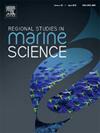Ecology intersects with mariculture: How cultivation depth and site-specific environmental factors shape growth and nutritional profile of green mussels (Perna viridis)
IF 2.1
4区 环境科学与生态学
Q3 ECOLOGY
引用次数: 0
Abstract
Understanding the interlinkages between ecological conditions and mariculture practices are vital for enhancing growth performance and nutritional profiling of marine bivalves. However, highly productive mariculture practices under different local ecological conditions have not been comprehensively documented to achieve sustainable outcomes. This study investigates how depth (0.5 m, 1 m, and 1.5 m) and site-specific ecological factors of three farming sites (Moheshkhali, Khurushkul, and Choufaldandi) influence the growth performance and nutritional profile of green mussels (Perna viridis) in floating raft mariculture systems in the southeast coast of the Bay of Bengal, Bangladesh. For this purpose, 20 uniform green mussel spats (2.9 ± 0.08 g) were inoculated across three cultivation depths in ten replicated mussel net socks, which were suspended vertically in the water column from horizontal floating rafts and cultured for six months (October-March) at the above-mentioned three farming sites. Among environmental factors, the two-way ANOVA model displayed both depth- and site-specific significant variation of ecological parameters (DO, salinity, turbidity, NO3-N, PO4-P, Chlorophyll-a) and food availability (Coscinodiscophyceae, Bacillariophyceae, Chlorophyceae, and Dinophyceae) in the studied areas. Our findings based on the two-way ANOVA model also revealed that both the depth and site-specific ecological settings significantly impact (p < 0.05) growth performance, shell morphometry and nutritional profiles of green mussels. Various univariate and multivariate analyses further revealed that the above ecological factors are closely interlinked with the observed differences in growth performance and nutritional profiles of mussels. By integrating these ecological and environmental variables, our study provides actionable insights for optimizing green mussel farming practices, potentially leading to improved yield and nutritional quality in floating raft systems.
求助全文
约1分钟内获得全文
求助全文
来源期刊

Regional Studies in Marine Science
Agricultural and Biological Sciences-Ecology, Evolution, Behavior and Systematics
CiteScore
3.90
自引率
4.80%
发文量
336
审稿时长
69 days
期刊介绍:
REGIONAL STUDIES IN MARINE SCIENCE will publish scientifically sound papers on regional aspects of maritime and marine resources in estuaries, coastal zones, continental shelf, the seas and oceans.
 求助内容:
求助内容: 应助结果提醒方式:
应助结果提醒方式:


